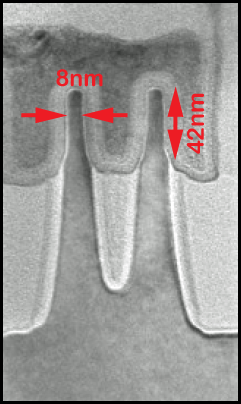50 Years of Moore’s Law
Nothing is forever, that includes exponential functions. The Limits to Growth also apply to Moore’s Law, and it’s almost a miracle that it’s been working so well up to now. Already in 2015 we’ve seen the first 14 nm ICs hit the shelves. This figure refers to the node technology and it just can’t continue shrinking. As we can see on recent Intel’s FinFETs, the fins are just 8 nm wide. The lattice spacing of silicon is 543 pm, which works out at only 15 atoms lying horizontally. Oh, and don’t forget a sprinkling of SiO2 molecules for insulation purposes.
It doesn’t take a genius to work out that the geometry just can’t go on shrinking indefinitely, where is the physical limit; 10 nm? Okay. 7 nm? Well, probably but 5 nm, seriously? That’s the width of just 5 atoms of silicon! It might be that down at this scale, material migration, tunnel and quantum effects, as well as unachievable manufacturing precision, coupled with the exponential rise in production costs will make miniaturization on this scale uneconomic. So it looks like we might need to say bye bye to Moore’s Law in, say 5 years time? Well yes… and no.
Did you know?
The first IC was invented by Jack Kilby in 1958. One year later, in 1959, Robert Noyce introduced the first monolithic IC. The integration of several dozen components in the same chip is called SSI (Small Scale Integration). The successful adoption of these techniques has been possible thanks partly to large investments made by NASA during the Apollo program and the US Army for the development of nuclear weapons.
It doesn’t take a genius to work out that the geometry just can’t go on shrinking indefinitely, where is the physical limit; 10 nm? Okay. 7 nm? Well, probably but 5 nm, seriously? That’s the width of just 5 atoms of silicon! It might be that down at this scale, material migration, tunnel and quantum effects, as well as unachievable manufacturing precision, coupled with the exponential rise in production costs will make miniaturization on this scale uneconomic. So it looks like we might need to say bye bye to Moore’s Law in, say 5 years time? Well yes… and no.
 |
Moore & More Moore At Elektor, we dare to predict that there will be no such let up in the inexorable march of Moore’s Law 2.0, and here we are talking 3-D structures and massively paralleled computing. Not convinced? Check this out: Samsung have just built a flash memory chip boasting 32 layers and there are already processors with more than 100 cores. Oh yeah, I don’t think Mr Moore’s law is likely to be derailed by mere physical constraints just yet, no its going to be around for a while, stay tuned! |
Did you know?
The first IC was invented by Jack Kilby in 1958. One year later, in 1959, Robert Noyce introduced the first monolithic IC. The integration of several dozen components in the same chip is called SSI (Small Scale Integration). The successful adoption of these techniques has been possible thanks partly to large investments made by NASA during the Apollo program and the US Army for the development of nuclear weapons.
Read full article
Hide full article


Discussion (0 comments)